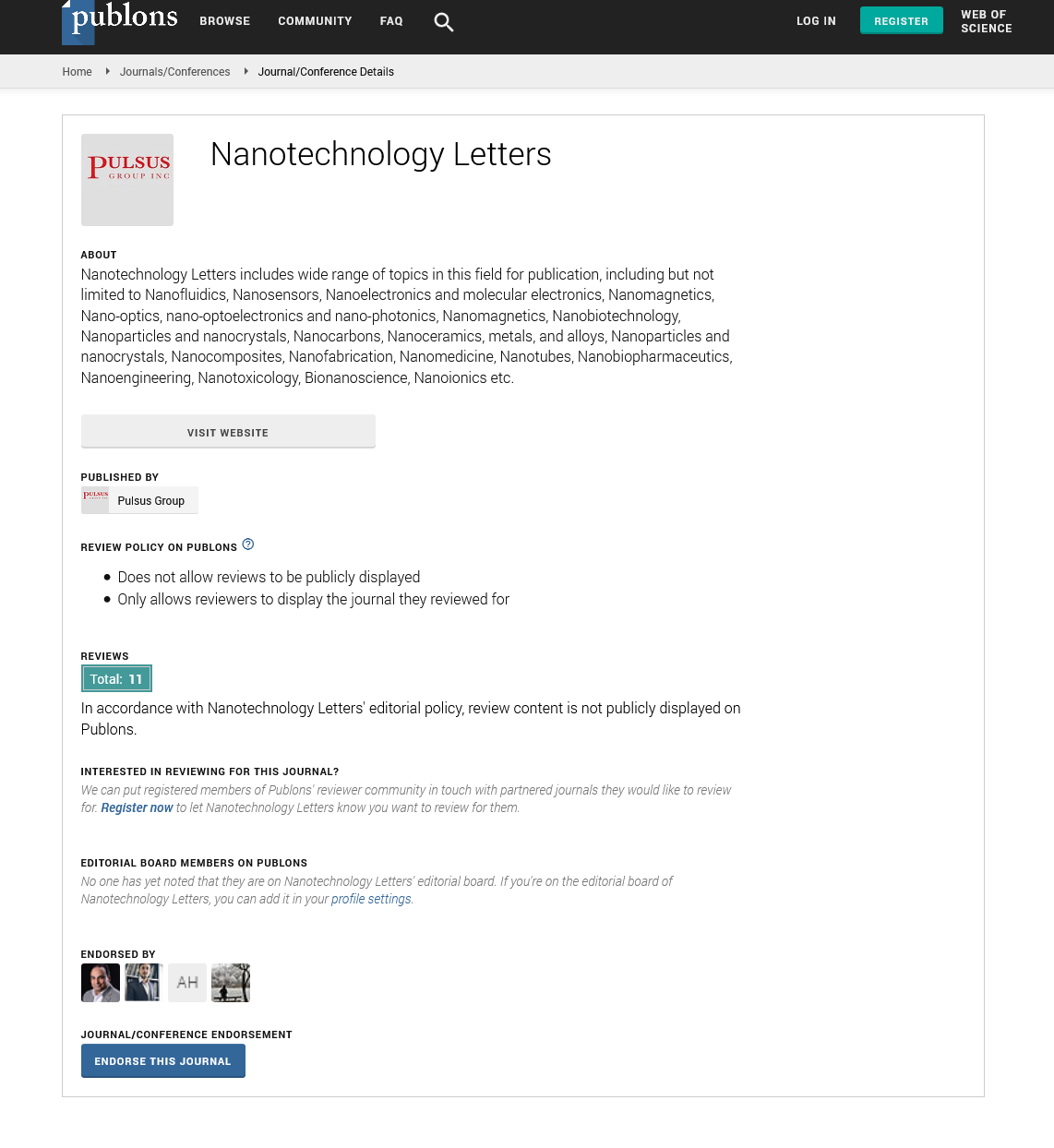Utilizing nanotechnology in plant genetic modification
Received: 08-Mar-2023, Manuscript No. pulnl-23-6773; Editor assigned: 10-Mar-2023, Pre QC No. pulnl-23-6773 (PQ); Accepted Date: Mar 26, 2023; Reviewed: 18-Mar-2023 QC No. pulnl-23-6773 (Q); Revised: 25-Mar-2023, Manuscript No. pulnl-23-6773 (R); Published: 29-Mar-2023, DOI: 10.37532. pulnl.23.8 (2) 31-32
Citation: Wilson J. Utilizing nanotechnology in plant genetic modification. Nanotechnol. lett.; 8(2):31-32
This open-access article is distributed under the terms of the Creative Commons Attribution Non-Commercial License (CC BY-NC) (http://creativecommons.org/licenses/by-nc/4.0/), which permits reuse, distribution and reproduction of the article, provided that the original work is properly cited and the reuse is restricted to noncommercial purposes. For commercial reuse, contact reprints@pulsus.com
Abstract
The escalating global demand for food due to a growing population necessitates the adoption of advanced agricultural practices aimed at enhancing crop yields, bolstering crop resilience in the face of unpredictable and extreme weather conditions, and minimizing production losses attributed to pests and diseases. To address these challenges, genome engineering techniques have been employed across various plant species. Over time, several generations of genome engineering methods have emerged, with the latest cutting-edge technology being Clustered Regularly Interspaced Short Palindromic Repeats (CRISPR) coupled with nucleases. A pivotal step in the genome engineering process involves the delivery of gene constructs into plant cells. Harnessing the potential of nanotechnology, the utilization of nanoparticles for gene delivery exhibits notable technical advantages compared to traditional methods, primarily owing to its exceptional efficiency and versatility across various plant species. This review provides a comprehensive overview of the development of techniques for delivering biomolecules to plants and delves into their attributes and constraints. Our emphasis is on the forefront of nanotechnology-based delivery systems, encompassing an exploration of diverse nanoparticle varieties, the fabrication of nanomaterials, the intricacies of nanoparticle transport mechanisms, and their advanced applications in the field of plant genome engineering.
Key Words
Genome engineering; Plant transformation; Nanotechnology; Nanoparticles
Introduction
At present, the global population surge, the impact of climate change, and the ongoing challenges posed by the COVID-19 pandemic are exerting significant pressure on agriculture and food security. Meeting the ever-growing food demands of the world's population necessitates urgent advancements in biotechnology. These advancements are crucial not only for enhancing crop yields and quality but also for mitigating losses caused by biotic and abiotic stresses. In recent years, genome editing has emerged as a pivotal tool in bolstering crop resilience to stress and ensuring food production and security. For instance, the modification of OsERA1 using the Clustered Regularly Interspaced Short Palindromic Repeats (CRISPR/Cas9) technique resulted in increased drought stress tolerance in rice plants. Conversely, rice mutants with edited SlHSA1 genomes displayed heightened susceptibility to temperature stress compared to wild-type crops. Despite the rapid progress in genetic engineering methods for various plant species, numerous plants still pose challenges when it comes to genetic transformation
Nanotechnology has found various applications in agriculture, including the use of nanosensors, nanopesticides, and nanofertilizers which have garnered significant attention in recent research. Notably, the utilization of nanoparticles for gene delivery in plants has gained widespread acceptance. These nanoparticles, characterized by their small size (ranging from 1 to 100 nm) and customizable physical and chemical properties, serve as effective carriers for transporting cargos that can bypass the plant cell wall and plasma membrane. Importantly, the delivery of molecular biology cargos like DNA, RNA, and proteins into plant cells has become increasingly crucial. Therefore, employing nanoparticle-mediated delivery of biomolecules offers a promising approach to overcome the limitations associated with conventional methods, ultimately enhancing transformation efficiencies in agricultural plant biotechnology. In this review, we explore various techniques employed in plant transgenics, with a specific focus on the advantages of applying nanotechnology, encompassing the development of nanocarriers for delivering plant genetic materials and nano-mediated plant regeneration.
CONVENTIONAL GENETIC TRANSFORMATION METHODS
In recent decades, plant genetic transformation has gained considerable attention as a prominent area of research. The evolution of traditional genetic engineering techniques has ushered plant biology studies into a new era. Nevertheless, these genetic engineering tools encounter obstacles posed by the formidable multilayered cell walls found in the majority of plant species, as well as difficulties in achieving successful plant regeneration, along with inherent limitations. This section provides an overview of various methods employed for plant transformation.
Gene gun-mediated transformation
Gene gun-mediated transformation, also known as particle bombardment, relies on a biolistic particle delivery technique and is frequently employed in plant genetic transformation. In essence, this method involves the generation of a cold gas shock wave within the bombardment chamber by utilizing compressed gas, which propels tiny gold particles loaded with DNA molecules. Under the influence of gas pressure, these gold particles, bearing DNA, traverse the cell wall, cell membrane, cytoplasm, and various structural layers to reach the nucleus, thereby accomplishing the transfer of genes.
Agrobacterium-mediated transformation
Agrobacterium, a Gram-negative bacterium commonly found in soil, naturally exhibits chemotaxis towards most dicotyledonous plants and can induce the formation of crown galls or hairy roots. The cells of Agrobacterium tumefaciens and Agrobacterium rhizogenes possess Ti and Ri plasmids, respectively, which carry a segment of T-DNA. When Agrobacterium infects plant cells through wounds, it introduces the target gene, and the T-DNA is integrated into the plant genome as a single strand, resulting in stable transformation. Due to its remarkable stability, straightforward procedure, and high efficiency, Agrobacterium-mediated transformation has emerged as the most widely employed technique in the realm of plant genetic engineering. Electroporation
Electroporation involves rapidly enhancing the permeability of cell membranes when subjected to a high-intensity electric field . In such conditions, it facilitates the diffusion of molecules from the external environment into the cell. This technology is capable of introducing nucleotides, DNA, RNA, proteins, dyes, and even virus particles into both prokaryotic and eukaryotic cells. Thanks to its noteworthy efficiency, precise dosage control, and broad applicability, electroporation has become a versatile tool extensively utilized in the fields of medicine and food biotechnology. Furthermore, the scope of electroporation has extended beyond in vitro research to encompass in vivo applications for intracellular delivery.
NANOPARTICLE-MEDIATED BIOMOLECULE DELIVERY
A nanoparticle is an artificially created minuscule particle, measuring less than 100 nm in size. This dimension places it below the size exclusion limits of cells, making it possible to finely manipulate its physical and chemical properties for precise interactions with biological molecules. Currently, nanoparticles have emerged as highly customizable tools with widespread applications in the fields of biomedical and agriculture. This has sparked significant interest in utilizing nanoparticles as transport vehicles for delivering bioengineering molecules in both animals and plants. Specifically, in mammalian systems, engineered nanoparticles can effectively transport molecular cargoes and therapeutic agents at a subcellular level, facilitating targeted delivery and precise control of cargo release to the nucleus or organelles.
APPLICATION OF NANOTECHNOLOGY IN PLANT GENETIC TRANSFORMATION
Nano Particle (NP)-mediated gene transformation systems have model plants and crops, effectively enhancing both transient and stable transformation .The small size, biocompatibility, tunable properties, and versatility of nanomaterials render them promising carriers for biomolecules in plants. One of the most significant roles of nanotechnology in plant genetic engineering lies in its capacity to precisely regulate the delivery of cargo to various plant species and tissues. Certain nanoparticles possess inherent fluorescence properties, allowing them to serve as imaging tools for tracking cargo delivery and release. Moreover, research has indicated that during transportation, NPs can provide cargoes with protection against degradation .Consequently; NPs can serve not only as vehicles for delivering plasmid DNA into intact plant cells for genetic transformation but also as carriers for small interfering RNA (siRNA), enabling post-transcriptional gene silencing and conferring disease resistance in crops. For instance, Zhang et al. achieved effective gene knockout by employing DNA nanostructures and carbon nanotubes to directly deliver siRNA. Furthermore, NPs offer the possibility of distributing proteins to plants, enabling DNA-free editing and facilitating the advancement of genome editing in plants.
APPLICATION OF NANOTECHNOLOGY IN GENE EDITING
Genome editing is an innovative genetic engineering technology that enables the modification of specific target genes within an organism's genome. Early genome engineering techniques were limited to the random insertion of foreign or endogenous genetic material into the host genome. However, the emergence of nuclease-enabled genome editing methods has facilitated more precise modifications of specific target genes in the genome. Currently, there are four classes of engineered nucleases employed to create specific-site Double-Strand Breaks (DSBs): Meganuclease, Zinc Finger Nucleases (ZFNs) Transcription Activator-Like Effector Nucleases (TALENs), and the widely used Clustered Regularly Interspaced Short Palindrome Repeats (CRISPR)/CRISPR-associated protein 9 (Cas9) system. These methods generate site-specific DSBs at designated locations in the genome, prompting organisms to repair DSBs via Non-Homologous End-Joining (NHEJ) or homologous recombination (HR), ultimately resulting in gene replacement
In the CRISPR/Cas9 system, two components, namely Cas9 endonuclease and sgRNA, need to be simultaneously delivered. In genetic engineering, CRISPR plasmids can prevent the random integration of transgenes, thanks to the assistance of carbon nanotubes, which facilitate transient expression for permanent editing. Currently, three types of cargo are utilized for the delivery of the CRISPR/Cas system. The simplest approach involves Ribonucleoprotein (RNP), which does not require transcription or translation but is hindered by the high molecular weight of the Cas9 protein. The second delivery strategy is the transfection of sgRNA plasmids, where corresponding plasmids are incorporated into the same transfer plasmids to execute gene mutations. However, the transfection efficiency is diminished due to the large gene fragment of the CRISPR/Cas9 system. Another cargo option is Cas9 mRNA. Simultaneously delivering Cas9 mRNA and sgRNA into cells allows direct protein translation. Nevertheless, the instability and transient expression of mRNA limit its broader application.






